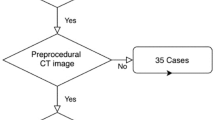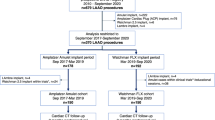Abstract
Purpose
The present paper analyzes the role of different imaging modalities for left atrial appendage (LAA) assessment and the recommended specific measurements to improve device selection with regard to the Amulet device.
Background
Morphological LAA assessment is one of the pivotal factors to achieve proper LAA sealing and potentially reduce the risk of complications by minimizing manipulation inside the appendage.
Methods
Eight experienced physicians in LAAO were asked to contribute in the preparation of a device sizing consensus manuscript after comprehensive assessment of previous published data on LAA imaging/measurement.
Results
LAA morphology is often complex and requires more detailed spatial resolution and 3-dimensional assessments to reduce the risk of mis-sizing. Traditionally, upsizing of devices based upon the largest measured LAA diameters have been used. However, this may lead to oversizing in markedly elliptical appendages. Thus, when 3D imaging modalities are available, utilizing the LAA mean diameters might be a better alternative. Operators should also note the systematic biases in differences in measurements obtained with different imaging modalities, with CT giving the largest measurements, followed by 3D-TEE, and then 2D-TEE and angiography. In fact, for 2D imaging techniques (2D-TEE and angiography), LAA diameters tend to be underestimated, and therefore, LAA largest diameters seem to be still the best option for device sizing. Some specific anatomies such as proximal chicken-wing or conic LAAs may require different measurements and implantations to achieve implant success.
Conclusions
In conclusion, LAA mean diameters might be a better alternative to largest diameters when 3D imaging modalities are available.







Similar content being viewed by others
References
Tzikas A, Shakir S, Gafoor S, Omran H, Berti S, Santoro G, et al. Left atrial appendage occlusion for stroke prevention in atrial fibrillation: multicentre experience with the amplatzer cardiac plug. EuroIntervention. 2015;10. https://doi.org/10.4244/EIJY15M01_06.
Boersma LV, Schmidt B, Betts TR, Sievert H, Tamburino C, Teiger E, et al. investigators E. Implant success and safety of left atrial appendage closure with the watchman device: peri-procedural outcomes from the evolution registry. Eur Heart J. 2016;37:2465–74.
Tzikas A, Freixa X, Ibrahim R. Left atrial appendage occlusion for stroke prevention in patients with atrial fibrillation: ready for the prime time? Expert Rev Cardiovasc Ther. 2013;11:1587–9.
Tzikas A, Gafoor S, Meerkin D, Freixa X, Cruz-Gonzalez I, Lewalter T, et al. Left atrial appendage occlusion with the amplatzer amulet device: an expert consensus step-by-step approach. EuroIntervention. 2016;11:1512–21.
Tzikas A, Holmes DR Jr, Gafoor S, Ruiz CE, Blomstrom-Lundqvist C, Diener HC, et al. Percutaneous left atrial appendage occlusion: the munich consensus document on definitions, endpoints and data collection requirements for clinical studies. EuroIntervention. 2016;12:103–11.
Hansson NC, Thuesen L, Hjortdal VE, Leipsic J, Andersen HR, Poulsen SH, et al. Three-dimensional multidetector computed tomography versus conventional 2-dimensional transesophageal echocardiography for annular sizing in transcatheter aortic valve replacement: Influence on postprocedural paravalvular aortic regurgitation. Catheter Cardiovasc Interv. 2013;82:977–86.
Chow DH, Bieliauskas G, Sawaya FJ, Millan-Iturbe O, Kofoed KF, Sondergaard L, et al. A comparative study of different imaging modalities for successful percutaneous left atrial appendage closure. Open heart. 2017;4:e000627.
Al-Kassou B, Tzikas A, Stock F, Neikes F, Volz A, Omran H. A comparison of two-dimensional and real-time 3d transoesophageal echocardiography and angiography for assessing the left atrial appendage anatomy for sizing a left atrial appendage occlusion system: impact of volume loading. EuroIntervention. 2017;12:2083–91.
Kerut EK. Anatomy of the left atrial appendage. Echocardiography. 2008;25:669–73.
Stollberger C, Ernst G, Finsterer J. Is the left atrial appendage our most lethal attachment? Eur J Cardiothorac Surg. 2000;18:625–6 author reply 627.
Al-Saady NM, Obel OA, Camm AJ. Left atrial appendage: structure, function, and role in thromboembolism. Heart. 1999;82:547–54.
Spencer RJ, DeJong P, Fahmy P, Lempereur M, Tsang MYC, Gin KG, et al. Changes in left atrial appendage dimensions following volume loading during percutaneous left atrial appendage closure. JACC Cardiovasc interv. 2015;8:1935–41.
Pollick C, Taylor D. Assessment of left atrial appendage function by transesophageal echocardiography. Implications for the development of thrombus. Circulation. 1991;84:223–31.
Nucifora G, Faletra FF, Regoli F, Pasotti E, Pedrazzini G, Moccetti T, et al. Evaluation of the left atrial appendage with real-time 3-dimensional transesophageal echocardiography: implications for catheter-based left atrial appendage closure. Circ Cardiovasc imaging. 2011;4:514–23.
Gloekler S, Shakir S, Doblies J, Khattab AA, Praz F, Guerios E, et al. Early results of first versus second generation Amplatzer Occluders for left atrial appendage closure in patients with atrial fibrillation. Clin Res Cardiol. 2015.
Nietlispach F, Gloekler S, Krause R, Shakir S, Schmid M, Khattab AA, et al. Amplatzer left atrial appendage occlusion: single center 10-year experience. Catheter Cardiovasc Interv. 2013;82:283–9.
Clemente A, Avogliero F, Berti S, Paradossi U, Jamagidze G, Rezzaghi M, et al. Multimodality imaging in preoperative assessment of left atrial appendage transcatheter occlusion with the Amplatzer cardiac plug. Eur Heart J Cardiovasc Imaging. 2015;16:1276–87.
Zhou Q, Song H, Zhang L, Deng Q, Chen J, Hu B, et al. Roles of real-time three-dimensional transesophageal echocardiography in peri-operation of transcatheter left atrial appendage closure. Medicine. 2017;96:e5637.
Shah SJ, Bardo DM, Sugeng L, Weinert L, Lodato JA, Knight BP, et al. Real-time three-dimensional transesophageal echocardiography of the left atrial appendage: initial experience in the clinical setting. J Am Soc Ecocardiogr. 2008;21:1362–8.
Rajwani A, Nelson AJ, Shirazi MG, Disney PJ, Teo KS, Wong DT, Young GD, Worthley SG. Ct sizing for left atrial appendage closure is associated with favourable outcomes for procedural safety. European heart journal cardiovascular Imaging. 2016.
Hell MM, Achenbach S, Yoo IS, Franke J, Blachutzik F, Roether J, Graf V, Raaz-Schrauder D, Marwan M, Schlundt C. 3d printing for sizing left atrial appendage closure device: head-to-head comparison with computed tomography and transesophageal echocardiography. EuroIntervention : journal of EuroPCR in collaboration with the Working Group on Interventional Cardiology of the European Society of Cardiology. 2017.
Frangieh AH, Alibegovic J, Templin C, Gaemperli O, Obeid S, Manka R, et al. Intracardiac versus transesophageal echocardiography for left atrial appendage occlusion with watchman. Catheter Cardiovasc Interv. 2017;90:331–8.
Korsholm K, Jensen JM, Nielsen-Kudsk JE. Intracardiac echocardiography from the left atrium for procedural guidance of transcatheter left atrial appendage occlusion. JACC Cardiovasc interv. 2017.
Saw J. Intracardiac echocardiography for endovascular left atrial appendage closure: is it ready for primetime? JACC Cardiovasc interv. 2017;10:2207–10.
Nietlispach F, Krause R, Khattab A, Gloekler S, Schmid M, Wenaweser P, et al. Ad hoc percutaneous left atrial appendage closure. J invasive cardiol. 2013;25:683–6.
Masson JB, Kouz R, Riahi M, Nguyen Thanh HK, Potvin J, Naim C, et al. Transcatheter left atrial appendage closure using intracardiac echocardiographic guidance from the left atrium. Can j cardiol. 2015;31:1497 e1497–14.
Hemam ME, Kuroki K, Schurmann PA, Dave AS, Rodriguez DA, Saenz LC, et al. Left atrial appendage closure with the watchman device using intracardiac vs transesophageal echocardiography: procedural and cost considerations. Heart Rythm. 2019;16:334–42.
Freixa X, Tzikas A, Basmadjian A, Garceau P, Ibrahim R. The chicken-wing morphology: an anatomical challenge for left atrial appendage occlusion. J Interv Cardiol. 2013;26:509–14.
Author information
Authors and Affiliations
Corresponding author
Ethics declarations
Conflict of interest
XF, AA, AT, JS, JN, AG, BS, and DH are proctors for Abbott Medical.
Ethical approval
Since this manuscript is an expert consensus based on personal experience and previous published data, no specific ethical committee approval nor patient/animal consent were necessary.
Additional information
Publisher’s note
Springer Nature remains neutral with regard to jurisdictional claims in published maps and institutional affiliations.
Rights and permissions
About this article
Cite this article
Freixa, X., Aminian, A., Tzikas, A. et al. Left atrial appendage occlusion with the Amplatzer Amulet: update on device sizing. J Interv Card Electrophysiol 59, 71–78 (2020). https://doi.org/10.1007/s10840-019-00699-5
Received:
Accepted:
Published:
Issue Date:
DOI: https://doi.org/10.1007/s10840-019-00699-5




